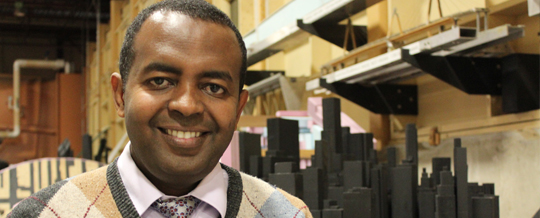Western helps Bitsuamlak to do research with impact
Western Engineering News | December 7, 2012
By Heather Travis
Girma Bitsuamlak felt drawn to Western University and its experts in wind engineering since he was a student; it just took him a few years to get here.
Having joined Western Engineering in January 2012, Bitsuamlak is the recently announced Tier 2 Canada Research Chair (CRC) in Wind Engineering. Bitsuamlak is an associate director at the WindEEE Research Institute.
“This is the best place in the world to do research on wind and the built environment,” he says.
A complex field of study tackled by small fraternity of people, Bitsuamlak sees both the art and science of wind engineering.
“Wind engineering is such a specialized field,” he continues. “(At Western) we have all we need from the wind tunnel, to Insurance Research Lab for Better Homes and WindEEE.
“I feel in terms of resources … I am sitting on the best dream tools.”
As the CRC, Bitsuamlak plans to focus on how to make buildings and the built environment – including emerging green technology and energy infrastructure – resilient to wind systems. This is not a simple question to answer, he notes, adding it is complicated by the new sustainability requirements.
While there is no way to prevent a destructive weather system, such as a tornado, it is possible to build structures strong enough to limit its damage and prevent loss of life.
“To do that, we need to understand the characteristics of tornadoes and its interaction with the built environment,” notes Bitsuamlak. “If we have the ability to make things fly – like airplanes – then we have the knowledge to prevent things from flying.
“As engineers, we are always learning from our mistakes.”
The shape of buildings affects wind loads used for design, so in order to make structures more resilient, researchers need to develop a better understanding of how winds interact with the built environment and explore the unique opportunity of favourably altering the wind effects.
As a graduate student at the Indian Institute of Technology Roorkee, India, Bitsuamlak was introduced to wind engineering through his professor who worked at India’s only Boundary Layer Wind Tunnel at the time. He was impressed by the facility, as well as the use of computer-aided design for structural applications.
He credits this experience as defining his research career and giving him versatility: “I don’t consider myself an experimentalist or computationalist – I am person who can use both of them as a tool… to solve an engineering problem.”
During his studies, Bitsuamlak poured over papers written by Western professors or alumni. One of them was Concordia University professor Theodore Stathopoulos, who studied under the late Alan G. Davenport at Western. After speaking with Stathopoulos, he decided to move to Canada and complete his PhD.
Upon graduation, Bitsuamlak visited Western’s Boundary Layer Wind Tunnel Laboratory to speak with researchers at the facility, but the timing wasn’t quite right.
Rather, Bitsuamlak furthered his experience at RWDI, where he spent three years working on more than 100 wind induced structural responses and cladding wind load studies for tall buildings, large-span roofs and other wind sensitive structures. His most notable projects included the Freedom Tower (New York); Burj Khalifa Dubai (Dubai); Yankee Stadium (New York); Kowloon Union Square (Hong Kong); and Moscow City Site Tower (Moscow).
Wind engineering is an evolving field. Throughout his work, Bitsuamlak found he had more questions than answers and was drawn back to academia and research.
He joined Florida International University, where he helped establish a very active wind engineering research group and expanded the Wall of Wind full-scale experimental hurricane research facility, capable of simulating up to a Category 5 hurricane wind speeds.
Throughout his career, Bitsuamlak kept his sights on Western and the chance to work at with some of the leading researchers in wind engineering. The CRC position seemed like the perfect opportunity.
“When I sat down, it was clear to me – Western is the epicenter of wind engineering,” he says, making the decision to move yet again quite simple.
Now that he is at the university, Bitsuamlak intends to tackle the same question that plagued Alan G. Davenport: ‘how do you make buildings safer?’
Access to Western’s SHARCNET means Bitsuamlak can easily continue his computational research, he notes, adding the university’s support of interdisciplinary research allows him to collaborate with colleagues across campus.
“I don’t have to worry about the resources; I can focus on my students and research,” he says. “Now I can really do something of good impact.”
Also from this web page:p>
Contact
.: Allison Stevenson
Spencer Engineering Building, Room 2074
T: .519.850.2917
F: 519.661.3808
contactwe@eng.uwo.ca


